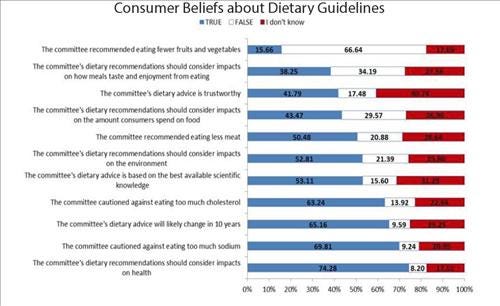Recent released preliminary dietary guidelines registering no measurable effect on meat demand, yet.
March 23, 2015

In February, the 2015 Dietary Guidelines Advisory Committee - consisting of health and nutrition professional- submitted its preliminary dietary guidelines from Americans which also included the impact the U.S. diet had on the environment (Feedstuffs Feb. 23 2015).
In the advisory report, the committee stated “current evidence shows that the average U.S. diet has a larger environmental impact in terms of increased greenhouse gas emissions, land use, water use and energy use.”
Moreover, the committee concluded that a diet higher in plant-based and lower in animal-based foods would be more environmental friendly.

A result the committee proposed that the next edition of the dietary guidelines would highly recommend a plant-based diet with lean meats still being considered part of a healthy diet -just recommending lower levels of red and processed meats.
The meat and poultry industry expressed its continuous concerned with environmental impact being examined by a team of nutrition and health professionals.
Still, the consumer input in regards to the newly released preliminary dietary guidelines has not thoroughly been investigated during the development process of the final version.
Oklahoma State University economist Jayson Lusk and his team of researchers took on the task in the March “Food Demand Survey (FooDS)”.
In its ad hoc questions, the researchers asked U.S. consumers: “The Federal Dietary Guidelines Advisory Committee recently released preliminary dietary guidelines for Americans. Which of the following do you think is true?”
When asked about the trustworthiness of the committee’s dietary advice, 41.79% of the survey participants trusted the information whereas 40.79% did not find it reliable (figure).
The majority of partakers understood that the committee is recommending consuming less meat.
Overwhelming 74% of the consumers responded that the committee’s dietary advice should consider impacts on health.
However, the respondents were more divided if the dietary guidelines should consider other factors such as amount of money spent on food, the taste of the food and the environmental impact.
Only 43% of the consumers stated that committee’s dietary recommendations should consider the amount individuals spend on food while 38% believe the taste and enjoyment of meal should be reflected in the advice.
Interestingly, over half of U.S. consumers (52.8%) surveyed said the Federal Dietary Guidelines Advisory Committee should consider the impacts on the environment when it makes the federal dietary guidelines for Americans, 21% disagreed and 32% were unsure.
Additionally, 53% of the survey participants did think the best available scientific knowledge should be used in the next dietary guideline recommendations, which is in align with the meat and poultry industry perspective.
In official comments on the Dietary Guidelines Advisory Committee report, the North American Meat Institute stated “If our government believes Americans should factor sustainability into their choices, guidance should come from a panel of sustainability experts that understands the complexity of the issue and address all segments transportation, construction, energy management and all forms of agriculture”.
Yet, with all that said, over 65% of consumers participating in the March FooDS did believe the committee dietary advice will most likely change in 10 years.
Dietary guidelines impact
Despite the ongoing debate over the federal dietary guidelines, the new preliminary guidelines did not have a measurable effect on meat demand as consumer willingness-to-pay (WTP) for all meat products (except steak) increased from February to March, noted Lusk.
The WTP for pork chop climbed 12% while chicken breast WTP increased 8%. Similar, all meat products WTP are relative higher than this time last year.
You May Also Like

.png?width=300&auto=webp&quality=80&disable=upscale)

